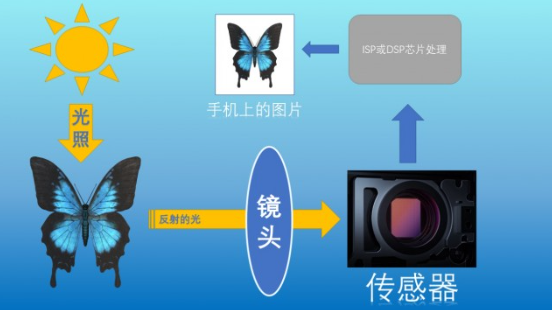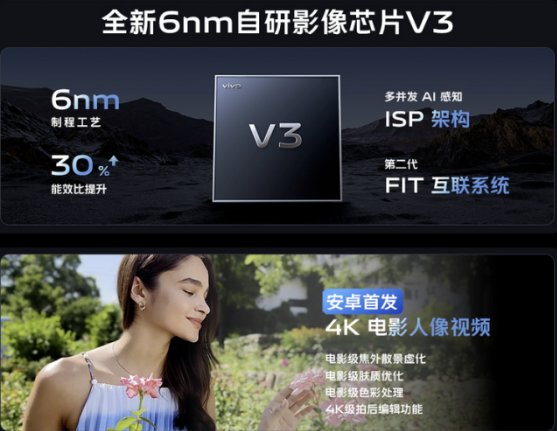 Technology peripherals
Technology peripherals
 It Industry
It Industry
 Revealing why vivo is so focused on camera technology in terms of imaging chips
Revealing why vivo is so focused on camera technology in terms of imaging chips
Revealing why vivo is so focused on camera technology in terms of imaging chips
At the special event of the vivo Imaging Festival, vivo launched a new self-developed V3 imaging chip, which is a new generation of self-developed imaging chips after V1, V1, and V2. The reason why vivo decided to independently develop imaging chips is mainly because imaging chips play a vital role in the process of taking pictures and videography on mobile phones
Currently, imaging chips, often called ISP chips, specialize in taking pictures and videography image signal at the time. These chips are responsible for converting the light signal entering the sensor from the lens into a digital signal, and performing noise reduction, sharpening, color optimization and other processing to finally generate the picture

Domestic mobile phone manufacturing The reason why manufacturers prefer to independently develop imaging chips is that compared to developing the entire SOC chip, the development cost and difficulty of ISP chips are lower. Therefore, through independent research and development of imaging chips, manufacturers such as vivo can better control the effects of mobile phone photography and gain unique advantages in market competition

According to my understanding, vivo’s latest The released V3 imaging chip uses a new 6nm process technology, combined with a multi-concurrent AI perception-ISP architecture and a second-generation FIT interconnection system, which improves energy efficiency by 30% compared to the previous generation. This V3 imaging chip provides users with a super experience of 4K movie portrait mode such as movie-level bokeh blur, fully automatic subject focus detection and switching, movie-level skin texture optimization, and movie color processing. This makes vivo the first Android mobile phone manufacturer to realize 4K movie portrait video, and the first mobile phone manufacturer to have 4K-level post-shooting editing functions

In addition to the upgrade of self-developed chips, Vivo has also comprehensively constructed a composite algorithm matrix, including one engine and two major systems. Through the new vivo origin imaging engine VOIE (vivo origin imaging engine), vivo has improved the underlying basic algorithm capabilities, improving image quality, color tone and computing power. In addition, vivo has also developed a super-sensing portrait system and a sky night scene system for core user scenarios such as portraits and night scenes, continuing to lead the era of computational photography. The continuous improvement of these technologies will bring better photography and imaging experience to vivo mobile phones
vivo's continuous innovation in the field of self-developed imaging chips has enabled it to win more users and customers in the fiercely competitive smartphone market. Recognition provides strong support
The above is the detailed content of Revealing why vivo is so focused on camera technology in terms of imaging chips. For more information, please follow other related articles on the PHP Chinese website!

Hot AI Tools

Undresser.AI Undress
AI-powered app for creating realistic nude photos

AI Clothes Remover
Online AI tool for removing clothes from photos.

Undress AI Tool
Undress images for free

Clothoff.io
AI clothes remover

Video Face Swap
Swap faces in any video effortlessly with our completely free AI face swap tool!

Hot Article

Hot Tools

Notepad++7.3.1
Easy-to-use and free code editor

SublimeText3 Chinese version
Chinese version, very easy to use

Zend Studio 13.0.1
Powerful PHP integrated development environment

Dreamweaver CS6
Visual web development tools

SublimeText3 Mac version
God-level code editing software (SublimeText3)

Hot Topics
 1386
1386
 52
52
 Vivo X200 Pro: Better camera and V4 AI chip teased. X100 and X90 Proto to come with camera feature of the Vivo X100 Ultra
Jul 31, 2024 pm 08:23 PM
Vivo X200 Pro: Better camera and V4 AI chip teased. X100 and X90 Proto to come with camera feature of the Vivo X100 Ultra
Jul 31, 2024 pm 08:23 PM
Vivo has not yet publicly announced the name of the X100 successor, but various teasers on its official Weibo profileare already talking about the next generation of flagship cameras, specifically the sensor technology that will replace the Sony IMX9
 Starting from 2,499 yuan, BOE announces exclusive supply of vivo S19/S19 Pro
May 31, 2024 pm 09:34 PM
Starting from 2,499 yuan, BOE announces exclusive supply of vivo S19/S19 Pro
May 31, 2024 pm 09:34 PM
According to news on May 31, BOE’s official Weibo announced that BOE exclusively supplies vivoS19 and S19Pro flexible OLED flagship ultra-clear eye protection screens. BOE introduced that vivo S19 and S19 Pro use BOE’s new generation Q9 light-emitting devices, and at the same time optimize the core light-emitting structure of the screen to achieve an overall improvement in screen performance. This screen has a local peak brightness of up to 4,500 nits, supports a 120Hz multi-frequency refresh rate, a DCI-P3 color gamut value of up to 105%, and supports 1 billion color full-color display and 1.5K ultra-high resolution, bringing smoothness and delicateness to users. visual enjoyment. In addition, the S19 series also adopts BOE’s ultra-high frequency 2160Hz PWM dimming mode and advanced low blue light eye protection technology to create a better experience for users.
 Vivo Y300 Pro packs 6,500 mAh battery in a slim 7.69 mm body
Sep 07, 2024 am 06:39 AM
Vivo Y300 Pro packs 6,500 mAh battery in a slim 7.69 mm body
Sep 07, 2024 am 06:39 AM
The Vivo Y300 Pro just got fully revealed, and it's one of the slimmest mid-range Android phones with a large battery. To be exact, the smartphone is only 7.69 mm thick but features a 6,500 mAh battery. This is the same capacity as the recently launc
 Not just Dimensity 9400! Vivo X200 Pro first exposed: double-curved screen becomes equal-depth quad-curved screen
Jun 21, 2024 pm 03:20 PM
Not just Dimensity 9400! Vivo X200 Pro first exposed: double-curved screen becomes equal-depth quad-curved screen
Jun 21, 2024 pm 03:20 PM
According to news on June 21, well-known digital blogger Digital Chat Station revealed that the screen form of this year’s vivo flagship X200Pro will be changed from the previous generation’s hyperbolic screen to the mainstream constant-depth four-curved screen. It is reported that vivoX200Pro will launch the Dimensity 9400 mobile platform, using the new Cortex-X5 ultra-large core. The platform uses the Blackhawk architecture and is based on the Armv9 instruction set, which greatly upgrades the performance of the Cortex-X5 ultra-large core. Dimensity 9400 will use TSMC’s 3nm process technology, which will significantly improve the energy efficiency and performance of the processor. In addition, according to the blogger, the screen form of vivoX200Pro will be changed from the hyperbolic screen of X100Pro to a constant depth screen.
 2024 Q1 Indonesian smartphone market report: Chinese brands shine, 5G shipments surge
Jun 05, 2024 pm 10:57 PM
2024 Q1 Indonesian smartphone market report: Chinese brands shine, 5G shipments surge
Jun 05, 2024 pm 10:57 PM
According to Counterpoint’s latest report, Indonesia’s smartphone shipments achieved a year-on-year growth of 4% in the first quarter of 2024. Among them, Chinese brands performed particularly well. In the market share distribution of specific product brands, vivo mobile phones ranked first with a market share of 19.2%, achieving a significant growth of 16% compared with 17.4% in the same period last year. Xiaomi mobile phones followed closely, occupying 18.6% of the market share, a significant increase of 55% compared with 12.5% in the same period last year. The market share of brands such as OPPO, Samsung and realme has declined. Among them, OPPO dropped from 23.0% in the same period last year to 17.0%, Samsung dropped from 18.3% to 16.7%, and realme
 5000mAh long-lasting large battery, good-looking new phone vivo Y37, hot-selling all over the internet
Jul 25, 2024 pm 03:19 PM
5000mAh long-lasting large battery, good-looking new phone vivo Y37, hot-selling all over the internet
Jul 25, 2024 pm 03:19 PM
Recently, the entry-level mobile phone market has ushered in a wave of new phones. Vivo’s latest Y37 smartphone has quickly become the focus of the market with its excellent 5000mAh large-capacity battery and exquisite appearance design. This phone not only meets users’ urgent need for long battery life, but also wins wide acclaim for its good looks and balanced configuration. One of the highlights of vivoY37 is undoubtedly its built-in 5000mAh ultra-large capacity battery. This configuration is extremely rare among similar products and can provide users with a long-lasting experience. Whether it is long-term game entertainment, continuous playback of high-definition movies, or daily social media browsing and online shopping, vivoY37 can handle it easily without frequent charging. According to vivo’s official website, it is equipped with 50
 Vivo X200: New photos via the Zeiss main camera and periscope telephoto appear to show a leap in quality
Sep 30, 2024 am 06:05 AM
Vivo X200: New photos via the Zeiss main camera and periscope telephoto appear to show a leap in quality
Sep 30, 2024 am 06:05 AM
Product manager Han Boxiao published the first sample photo from the Vivo X200 series on Weibo a few days ago, and now there are two. In the photos below, the first was taken with the 23mm equivalent main camera and the second with the 50 MP telephot
 An artifact for taking portraits at all focal lengths! vivo S19 series goes on sale: starting from 2,499 yuan
Jun 07, 2024 pm 01:15 PM
An artifact for taking portraits at all focal lengths! vivo S19 series goes on sale: starting from 2,499 yuan
Jun 07, 2024 pm 01:15 PM
According to news on June 7, today, the vivoS19 series is officially on sale, including two models, vivoS19 and vivoS19Pro, with starting prices of 2,499 yuan and 3,299 yuan respectively. As the king of the new generation of portrait phones, vivo S19 Pro is the first full-focus portrait camera in its class, achieving five portrait focal lengths of 24mm, 35mm, 50mm, 85mm, and 100mm. It can be called the "full-focus portrait photography artifact." It is also equipped with a studio-level zoom soft light ring and uses LCD electronically controlled dimming technology. When taking pictures, the light emission range and light point focus range of the soft light ring are automatically adjusted as the phone lens zooms. According to reports, vivoS19Pro has a rear 50-megapixel main camera, which is the first camera jointly developed with Sony.



